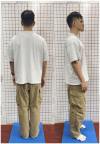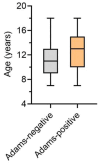Prevalence and determinants of adolescent idiopathic scoliosis from school screening in Xiaoshan District, Hangzhou, China
- PMID: 40606103
- PMCID: PMC12213709
- DOI: 10.3389/fpubh.2025.1595793
Prevalence and determinants of adolescent idiopathic scoliosis from school screening in Xiaoshan District, Hangzhou, China
Abstract
Objective: This large-scale epidemiological study aimed to determine the prevalence and associated risk factors of Adolescent Idiopathic Scoliosis (AIS) through school-based screening in Xiaoshan District, Hangzhou, China.
Methods: A prospective cross-sectional study was conducted from 2023 to 2024, involving a total of 172,127 students aged between 7 and 18 years. A two-phase screening protocol was implemented: Phase I included physical examinations (assessing shoulder asymmetry and spinal curvature) alongside the Adams Forward Bend Test (with an angle of trunk rotation [ATR] ≥ 5°), while Phase II confirmed diagnoses through radiographic evaluation (Cobb angle ≥10°). Multivariate logistic regression analysis was employed to evaluate demographic, postural, and lifestyle factors.
Results: The overall prevalence of AIS was found to be 1.23%, with a significant gender disparity observed (female: 1.71% vs. male: 0.92%, p < 0.001). Among the initial cohort of 4,482 screen-positive cases, hospital confirmation was obtained for 422 individuals, identifying a total of 199 AIS patients (146 mild cases, 47 moderate cases, and one severe case). Key risk factors identified included female gender (odds ratio [OR] = 2.742), postural abnormalities such as kyphosis (OR = 5.741), enrollment in junior high school (OR = 0.414), prolonged sedentary behavior exceeding 8 h per day (OR = 0.231), and family history of scoliosis (OR = 0.467). Notably, the prone position test effectively reduced false-positive rates by approximately 70.3%. Twin studies indicated no significant concordance regarding AIS diagnosis among siblings (p = 0.16).
Conclusion: This study establishes that the prevalence of AIS in Xiaoshan District is consistent with national data reporting an incidence rate of approximately 1.2%. It highlights specific susceptibility based on gender as well as modifiable lifestyle risks associated with this condition. The integrated screening protocol that combines postural assessment with the Adams test demonstrates clinical utility for early detection efforts in schools. These findings underscore the necessity for preventive strategies within educational settings that focus on promoting proper posture education and encouraging increased physical activity among students.
Keywords: adolescents; epidemiology; idiopathic scoliosis; prevalence; screening.
Copyright © 2025 Tu, Xu, Feng, Zhang and Zhuang.
Conflict of interest statement
The authors declare that the research was conducted in the absence of any commercial or financial relationships that could be construed as a potential conflict of interest.
Figures






Similar articles
-
Screening for Adolescent Idiopathic Scoliosis: Evidence Report and Systematic Review for the US Preventive Services Task Force.JAMA. 2018 Jan 9;319(2):173-187. doi: 10.1001/jama.2017.11669. JAMA. 2018. PMID: 29318283
-
Epidemiological trends and predictive factors of adolescent scoliosis in qingdao: insights from a Large-scale screening program (2022-2024).Eur Spine J. 2025 Aug 14. doi: 10.1007/s00586-025-09245-6. Online ahead of print. Eur Spine J. 2025. PMID: 40804499
-
Measures implemented in the school setting to contain the COVID-19 pandemic.Cochrane Database Syst Rev. 2022 Jan 17;1(1):CD015029. doi: 10.1002/14651858.CD015029. Cochrane Database Syst Rev. 2022. Update in: Cochrane Database Syst Rev. 2024 May 2;5:CD015029. doi: 10.1002/14651858.CD015029.pub2. PMID: 35037252 Free PMC article. Updated.
-
Strategies for enhancing the implementation of school-based policies or practices targeting risk factors for chronic disease.Cochrane Database Syst Rev. 2017 Nov 29;11(11):CD011677. doi: 10.1002/14651858.CD011677.pub2. Cochrane Database Syst Rev. 2017. Update in: Cochrane Database Syst Rev. 2022 Aug 29;8:CD011677. doi: 10.1002/14651858.CD011677.pub3. PMID: 29185627 Free PMC article. Updated.
-
Education support services for improving school engagement and academic performance of children and adolescents with a chronic health condition.Cochrane Database Syst Rev. 2023 Feb 8;2(2):CD011538. doi: 10.1002/14651858.CD011538.pub2. Cochrane Database Syst Rev. 2023. PMID: 36752365 Free PMC article.
References
MeSH terms
LinkOut - more resources
Full Text Sources
Medical
Miscellaneous

